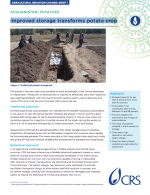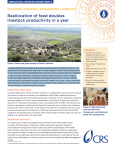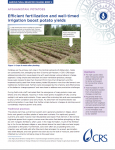Learning Briefs | October 17, 2019
Reduced seed rate and fertilizer adjustments build wheat resilience
AGRICULTURAL BEHAVIOR CHANGE: BRIEF 5
Risk reduction is a major factor influencing farmers’ perceptions and behaviors, and often leads to the inappropriate use of inputs. Throughout the rangelands of the Middle East and Central Asia, the risk of failure of the winter‑irrigated wheat crop exemplifies this concern. Whether encouraged by an often‑unconscious fear of the quality of local seed, or the subsidization of inputs by government or other bodies, farmers in many countries consistently use a very high seeding rate, and fertilize at inappropriate times. While visible differences during establishment would appear to favor this behavior (Figure 1), the intense competition between plants can eventually result in a considerable detrimental impact on final yield.
AGRICULTURAL BEHAVIOR CHANGE BRIEFS: INTRODUCTION
AGRICULTURAL BEHAVIOR CHANGE: BRIEF 1
AGRICULTURAL BEHAVIOR CHANGE: BRIEF 2
AGRICULTURAL BEHAVIOR CHANGE: BRIEF 3





